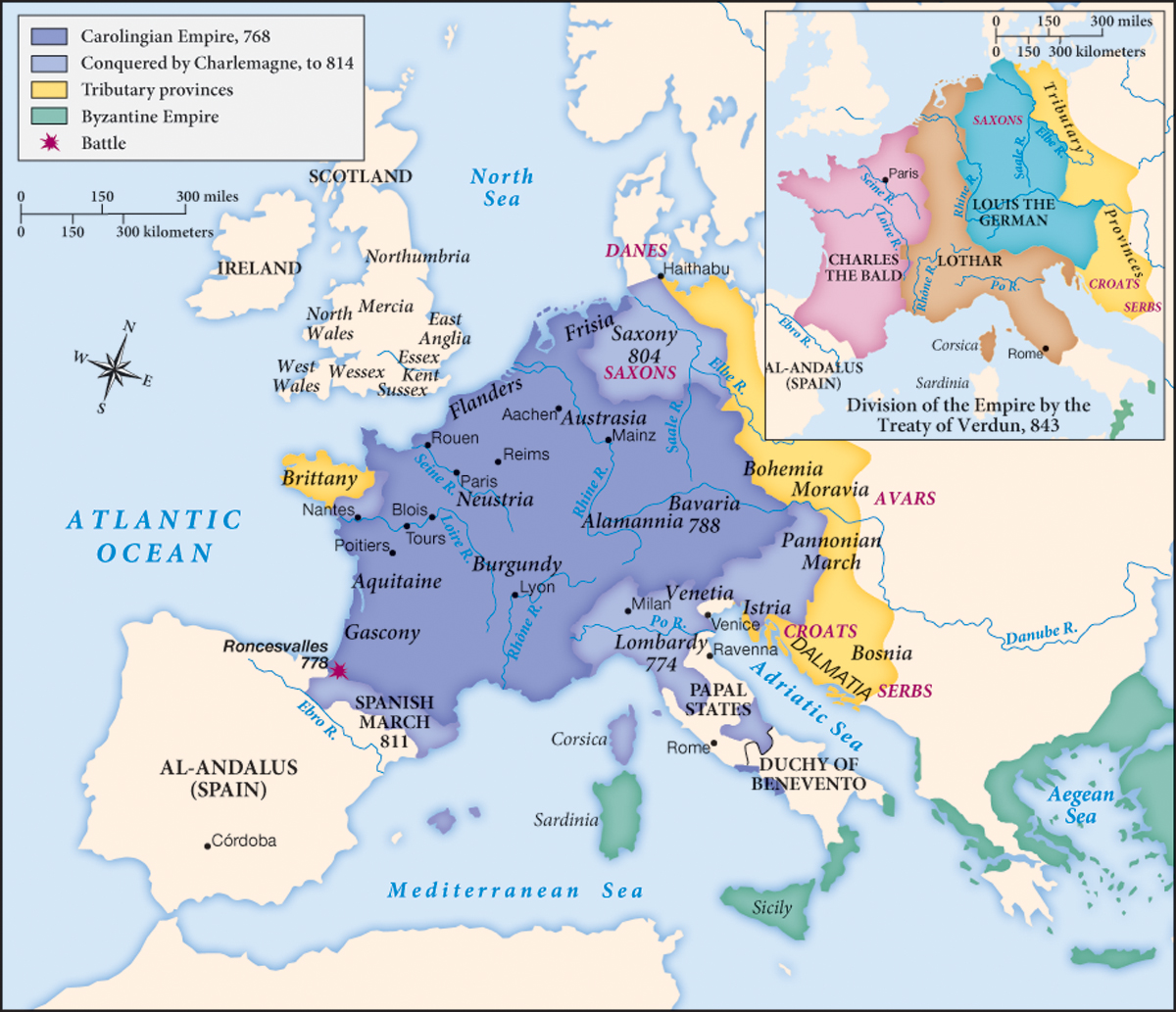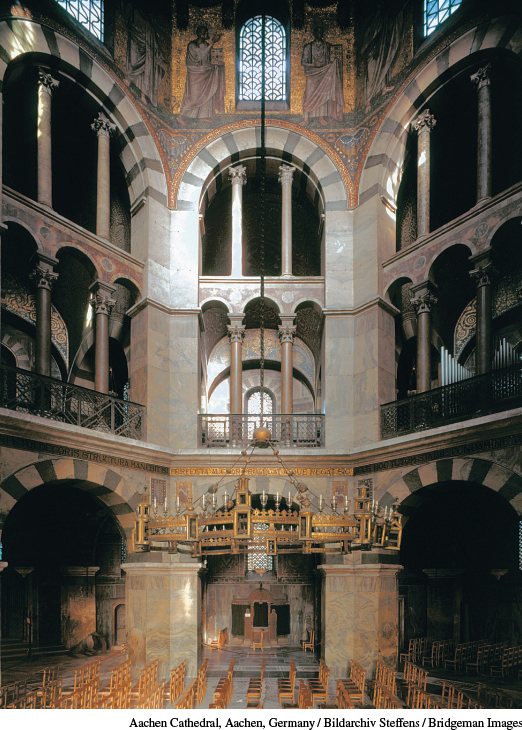Charlemagne and His Kingdom, 768–814
Printed Page 290
Important EventsCharlemagne and His Kingdom, 768–814
The most famous Carolingian king was Charles, whom his contemporaries called the Great (le Magne in Old French)—thus, Charlemagne (r. 768–814). Charlemagne was complex, contradictory, and sometimes brutal. He loved listening to St. Augustine’s City of God as it was read aloud, and he supported major scholarly enterprises, yet he never learned to write. He was devout, yet he flouted the advice of churchmen when they told him to convert pagans rather than force baptism on them. He admired the pope, yet he was furious when a pope placed the imperial crown on his head. He waged many successful wars, yet he thereby destroyed the buffer states surrounding the Frankish kingdoms, unleashing a new round of invasions.
Behind these contradictions, however, lay a unifying vision. Charlemagne dreamed of an empire that would unite the martial and learned traditions of the Roman and Germanic worlds with the legacy of Christianity. This vision lay at the core of his political activity, his building programs, and his support of scholarship and education.
During the early years of his reign, Charlemagne conquered lands in all directions (Map 9.3). He invaded Italy, seizing the crown of the Lombard kings and annexing northern Italy in 774. He then moved northward and began a long and difficult war against the Saxons, during which he annexed their territory and forcibly converted them to Christianity. To the southeast, Charlemagne fought the Avars, bringing home cartloads of plunder. To the southwest, he led an expedition to al-Andalus and there set up a march (a military buffer region).

By the 790s, Charlemagne’s kingdom stretched east beyond the Elbe River (today in Germany), southeast to what is today Austria, and south to Spain and Italy. Such power in the West had been unheard of since the time of the Roman Empire, and Charlemagne began to imitate aspects of the imperial model. He sponsored building programs to symbolize his authority, standardized weights and measures, and acted as a patron of intellectual and artistic efforts. He built a capital city at Aachen, complete with a chapel that was patterned on Justinian’s church of San Vitale at Ravenna (see the illustrations on pages 238 and 239 and below).

To discourage corruption, Charlemagne appointed special officials, called missi dominici (“those sent out by the lord king”), to oversee his regional governors—the counts. The missi (lay aristocrats or bishops) traveled in pairs throughout the kingdom to ensure that all, rich and poor alike, had access to royal justice.
Meanwhile, the papacy was beginning to claim imperial power for itself. At some point, perhaps in the 760s, members of the papal chancery (writing office) created a document called the Donation of Constantine. It declared the pope the recipient of the fourth-century emperor Constantine’s crown, cloak, and military rank along with “all provinces, palaces, and districts of the city of Rome and Italy and of the regions of the West.” (Only much later was the document proved a forgery.) The tension between the imperial claims of the Carolingians and those of the pope was heightened by the existence of an emperor at Constantinople who also had rights in the west.
Pope Leo III (r. 795–816) upset the delicate balance among these three powers. In 799, accused of adultery and perjury by a faction of the Roman aristocracy, Leo narrowly escaped being blinded and having his tongue cut out. He fled northward to seek Charlemagne’s protection. Charlemagne had the pope escorted back to Rome, and he soon arrived there himself to an imperial welcome orchestrated by Leo. On Christmas Day, 800, Leo put an imperial crown on Charlemagne’s head, and the clergy and nobles who were present acclaimed the king Augustus, the title of the first Roman emperor. The pope hoped in this way to exalt the king of the Franks, to downgrade the Byzantine ruler, and to claim for himself the role of “emperor maker.” (See “Contrasting Views: Charlemagne: Roman Emperor, Father of Europe, or the Chief Bishop?”)
At first, Charlemagne avoided using the imperial title. He may have hesitated to adopt it because he feared the reaction of the Byzantines. Or perhaps he objected to the papal role in his crowning since it seemed to give the pope power over the imperial office. When Charlemagne finally did call himself emperor, he used a long and revealing title: “Charles, the most serene Augustus, crowned by God, great and peaceful Emperor who governs the Roman Empire and who is, by the mercy of God, king of the Franks and the Lombards.” According to this title, Charlemagne was not the Roman emperor crowned by the pope, but rather God’s emperor who governed the Roman Empire along with his many other duties.